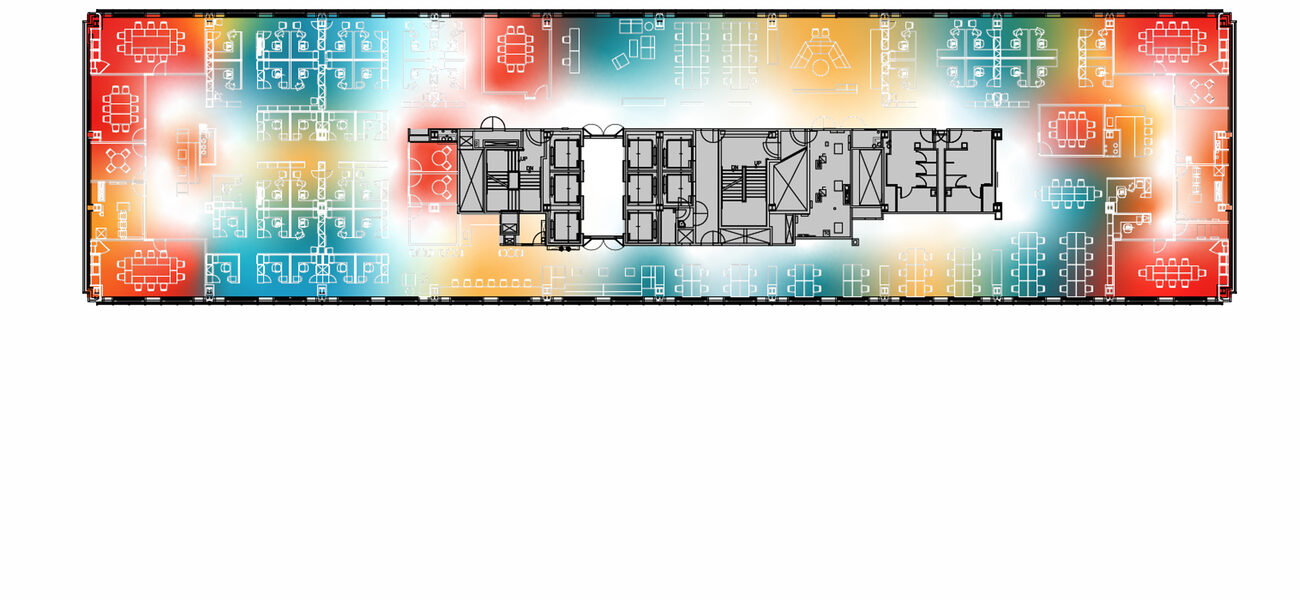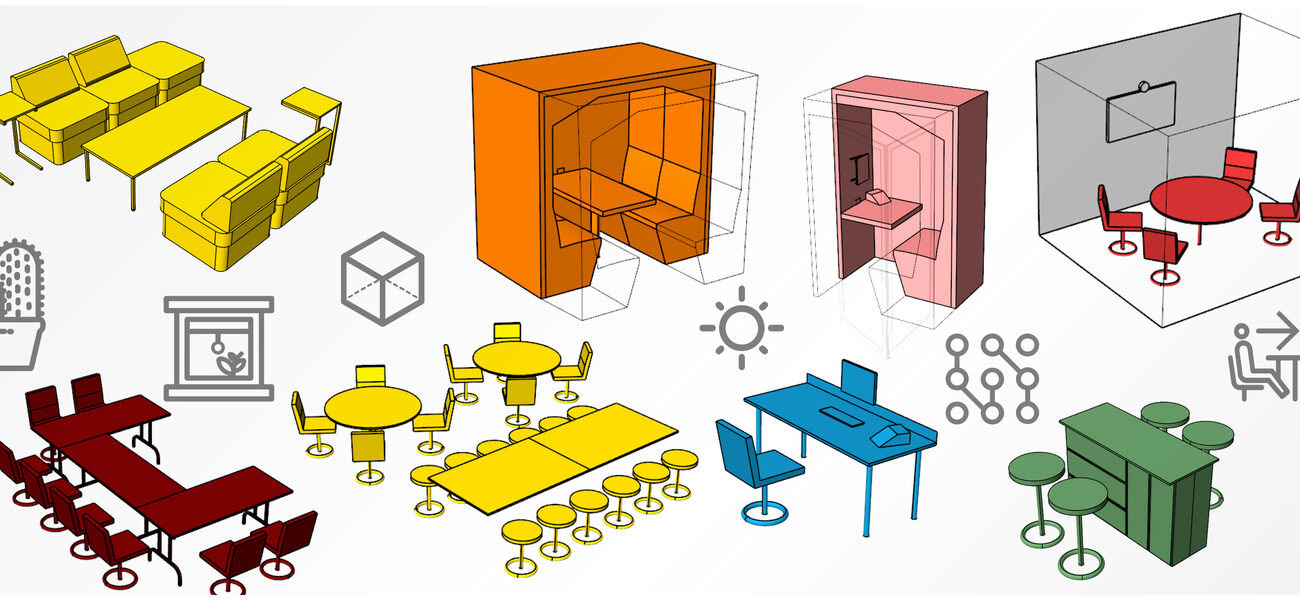Employees are driving the design of their workspaces like never before—demanding more collaborative environments, flexible spaces, and personalized technology. As a result, the focus of workplace design and operations, and overall facilities management, is evolving “from the responsibility of managing the building to the opportunity to enable the people within that building,” says Melissa Marsh, AIA, founder and executive director of PLASTARC. Marsh points to the rise of coworking as the disruptive innovation that sparked this shift, and the purposeful use of technology as the force that will sustain it.
“Coworking is changing our expectations of the workplace,” says Marsh. “And I’d argue that this isn’t just a trend. We’re not going to see things go back from this coworking or flexible workplace model.” The sharing economy has altered people’s priorities around their workspace the way Lyft and Uber have changed their perception around transportation, she says. Just as it’s more important to have the ability to get from one place to another than it is to own the vehicle, it’s also more important to have a high-performing, high-quality workspace available when you need it than it is to “own” your desk or office.
Existing technology can be tapped to enhance the user experience. Room booking programs, for instance, collect trace data about what spaces are most in demand. That data can be used to populate a facility with precisely the workspaces the occupants need, and to help them locate spaces with the characteristics they seek, by offering a pop-up message that says, “Conference Room C is not available. You might consider Conference Room H, which has the following similar features.”
Increasingly, the technology used in the workplace is also driven by the employees, who have the most current versions of the software they are most comfortable using. “Only 22 percent of U.S. employees feel that their workplace technology is more user friendly than their personal technology,” says Shannon Woodcock managing director of workplace strategy at Savills. “It’s not the workplace informing your personal life anymore; it’s what you do in your personal time informing what happens in the workplace.” That has led employers to open their doors to new technology of the employee’s choosing.
Diversity by Design
More diverse workplaces generate a need for more diverse workplace design, not only by offering a variety of workstations to suit individual work styles, but also by catering to a variety of cognitive differences in the way a space impacts a person on a sensory level.
“For example, as we age, our hearing changes,” says Marsh. “So, if we are being age diverse, we need different kinds of acoustic environments.” Different people also require different amounts of sunlight.
Another tangible manifestation of diversity in the workplace is the variety of amenities a company offers its employees, which will become all the more important as people return to the office after the pandemic.
Data gathered by PLASTARC shows that pre-COVID, people were accustomed to working outside of the office 1.5 to 2 days a week, not necessarily from home but traveling for business. It’s predicted that will increase to 2.5 to 3 days a week post-COVID.
“Amenities will play an important role in their lifestyle and rhythm as they come into the office,” says Marsh. “The pressure for the amenities to be truly attractive will be even more important in the future. The problem with amenities is that they have been pursued without the kind of research we do; they tend to be biased toward white males in their 40s. They’re not asking users what they want. It’s one of the most biased sets of services in the corporate world.”
Breaking through that bias requires a conversation about intimate topics not typically discussed at work: gender issues around restrooms, accommodations for breastfeeding, and religious practices.
“I think we are just at the tip of the iceberg in terms of what this platform could look like,” says Marsh.
Rethinking Building Metrics
Facility owners and planners traditionally think of building metrics as the number of square feet per person and the cost per square foot: The highest number of people in the smallest footprint yields the most efficient building. Not necessarily, argues Marsh. Buildings can also be measured by other characteristics that impact the occupants in ways that may make them work more efficiently: accessibility, ergonomics, connection, indoor air quality, health and wellness, food quality, collaboration space, serendipitous interaction, and transparency and communication.
Smart building technology, combined with the dozens of sensors embedded in smart phones, is providing the feedback necessary to track the importance of these less tangible building features.
“A true smart building is not just a building that is filled with new technology and sensor systems, but it’s a building that is set up to interact with the occupants, predominantly through our mobile devices,” says Marsh. “That smart building is really a social building, one that is activated by people through social and mobile media.”
These technologies allow users to control their environment, from temperature to lighting to physical setting. And each interaction between occupants within a building, or between an occupant and the building itself, is recorded as a data point.
“That is really where we’ll see the swell of information coming from,” she says. “Not just from the building or from our mobile devices, but from the interface between them.”
For example, Comfy is an app that allows the user to adjust the temperature in their space. Now the app can tell a user which spaces in the building are being held at the temperature they prefer.
“When we feel that our needs are being attended to, we become more flexible by several degrees in each direction,” explains Marsh. “Heating and cooling the building does not have to perform to such a narrow margin, and can be significantly more sustainable.”
Built into this facility data is occupant location data: “85 percent of data points being generated have a location-specific function or have location information embedded in it,” says Marsh. The LinkedIn phone app, for example, contains a feature that notifies you if any of your LinkedIn connections are nearby.
Apps tied to building information need to provide a benefit for the user so they will feel comfortable sharing data with building operators. “It’s a social contract,” says Marsh. “There needs to be a give and take: The building operator collects the occupant’s data, and in exchange, uses that data to provide an improved user experience for the occupant.”
And of course, in the age of COVID, this level of contact tracing—something perfected by coworking facilities—is critical. “Room booking or space booking was a nice-to-have before,” says Marsh. “Now it’s essential for contact tracing.
“Every single factor of coworking from a user experience point of view—spatial diversity, flexibility from a tech perspective—was better than any corporation at contract tracing,” she says. “They know so-and-so was in the building on these days at these times on this floor. That is currently less true in a corporate environment than in a coworking environment. The coworking operator considers cleanliness to be core to the value they provide.”
Marsh recommends that corporations take a page from coworking and require desks to be cleared off at the end of every workday so they can be properly cleaned. “How can a work surface ever be cleaned if it’s not clear?” she says. “I’m encouraging companies to have a clean-desk policy even if the seats are assigned.”
“It’s not theoretically impossible for a corporation to have the same level of accountability control as a coworking space, but I have yet to see it,” says Marsh.
Data Collection and Usage
We have access to more data than ever before, but more is not always better, says Marsh. In fact, collecting too much data simply because it’s available can be overwhelming, and ultimately, unhelpful. It’s important to collect data with intentionality; Marsh recommends that people use the scientific method to target their data collection.
“We need better hypotheses going into the data in order to avoid a boil-the-ocean perspective,” she says.
Be prepared to have your hypotheses disproven, because the data often does not support the owner’s preconceived ideas of what occupants value in a building. One case study involved the creation of a heat map to illustrate the utilization of a very expensive piece of real estate that featured large, redundant conference rooms and reception areas. A researcher walked the building seven hours a day for three days collecting 6,000 data points about whether each space was being used and by how many people.
The first thing that the heat map revealed was that people congregated in three separate zones across the floorplate, which gave the workspaces a disjointed feeling. Second, most of the activity was happening in the interior of the floorplate, away from the windows. Third, and perhaps most interestingly, the high-cost spaces were the least active, which started a conversation about eliminating the redundancies. That revelation also led to soul-searching about whether it was worth it to keep the gym. The obvious answer was “no,” but a user survey shed light on what the company valued.
“Everyone was so obsessed with the gym, and it was such a talent attraction tool,” says Woodcock. Instead of getting rid of it, they relocated it and improved it.
“It’s really important to recognize that once we get the data, there are several courses of action, and maybe we should focus on information, communication, and different operations before we say there’s no utility in it,” adds Marsh.
As companies pivot and adjust to conditions during the pandemic, many are questioning whether people’s priorities about what they value in a workspace will change. Marsh doesn’t think so.
“People will still value wellness, connectivity, and a sense of community,” she says. “COVID will change how we deliver them, but it hasn’t changed what matters. Community is not cocktail parties anymore, but reinforcing the culture.”
Marsh cautions that occupancy data has less value in facilities where the occupants have less choice about the spaces they occupy. “But when people have freedom and discretion, occupancy data becomes a much richer metric, because people are going to go to the spaces that serve their needs.” They might not even be conscious of why they are choosing a particular location, be it for higher acoustical performance, more daylight, or proximity to the café.
Another case study disproved the notion that younger workers are much more likely to want open, collaborative workspaces than their more tenured coworkers. In fact, the data shows that younger workers do almost as much heads-down work as their older peers.
“We really need to drop this idea that all young people want to be freely collaborating and moving about in the open space,” says Woodcock. “We have to take this into consideration.”
“Go with a hypothesis and a need to prove yourself wrong, as scientists are meant to do, as opposed to going through with those assumptions and looking for ways to prove yourself right,” says Marsh. “And don't let good data go bad. I think of unactioned data as milk that spoils in the fridge. The biggest failure in our industry is collecting the data and not using it.”
By Lisa Wesel

